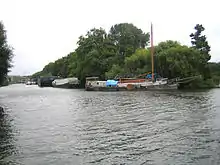Isleworth Ait
Isleworth Ait, also known as Isleworth Eyot, is a between 3.5-hectare (8.6-acre) and 9.370-acre (3.792 ha) teardrop-shaped island in the River Thames in England.[1][2] The long ait is on the Tideway facing Old Isleworth and the towpath alongside the Royal Mid-Surrey Golf Club. These places are in the London Boroughs of Hounslow and Richmond upon Thames. The island faces Heron's Place and a number of commercial buildings.


Wildlife
Isleworth Ait is covered by densely packed trees, and provides a sanctuary for a variety of wildlife. It floods regularly, but is home to more than 57 species of bird life, including the tree-creeper, kingfisher and heron. Two rare species of air-breathing land gastropods also live on the island, the two-lipped door snail Balea biplicata and the German hairy snail Pseudotrichia rubiginosa, as well as several rare species of beetles. This variety of unusual wildlife makes the island one of the London Wildlife Trust's most remarkable reserves. It is a Local Nature Reserve[3][4] and part of The River Thames and tidal tributaries Site of Metropolitan Importance for Nature Conservation.[5][6]
Trade
Isleworth Ait was once a centre for the production of osier - a willow which used to be harvested on the island to weave baskets to carry fruit and vegetables grown in Middlesex to the markets in London. Much of the island has resulted from five pre-19th century neighbouring islands, overall covering a broader area and partially reduced by river erosion intensified by passing boat traffic. The River Crane flows into the Thames to the south of the land and the Duke of Northumberland's River facing the other.
Ownership
Thames Water owns the island, which houses much of the treated outfall from the Mogden Sewage Treatment Works covering the outer West London areas generally benefitting from separate surface water drainage, which keeps untreated discharges to a moderate level compared to the combined sewers constituting many of the former subterrean rivers of London. Excess discharges from all these outfalls are to be collected by a 2010s-built tunnel
The Metropolitan Water Board bought the ait from the Duke of Northumberland in the 1930s; visitor access is granted to local volunteers of the London Wildlife Trust.
See also
References
- "Isleworth Ait". London Wildlife Trust. 2007. Retrieved 21 March 2010.
- OS 25-inch map of 1910 Ordnance Survey London sheet XCVI revised 1891-94, published 1897.
- "Isleworth Ait". Local Nature Reserves. Natural England. 5 March 2013. Retrieved 7 January 2014.
- "Map of Isleworth Ait". Local Nature Reserves. Natural England. Retrieved 7 January 2014.
- "The River Thames and tidal tributaries". Greenspace Information for Greater London. 2013. Archived from the original on 3 March 2016. Retrieved 7 January 2014.
- "iGiGL – helping you find London's parks and wildlife sites (map)". Greenspace Information for Greater London. 2013. Archived from the original on 29 November 2012. Retrieved 7 January 2014.
External links
| Next island upstream | River Thames | Next island downstream |
| Corporation Island | Isleworth Ait | Lot's Ait |